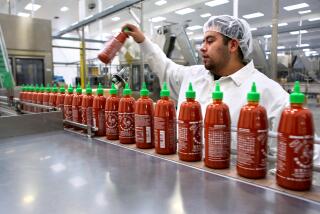FUROR OVER FRUIT FROM CHILE : Produce Sections : Grocers Restocking Shelves, Allaying Customers’ Fears
- Share via
First thing Tuesday morning, produce manager Michael S. Sakamoto yanked out the Chilean grapes from the shelves and replaced them with cut melons, limes and papayas.
He then spent the day allaying fears and talking to customers at the Hub Mart in Silver Lake about the latest news of tainted Chilean fruit and chemicals in apples. “The bananas are from Central America and the melons are from Mexico, so you don’t have to worry about them--yet,” he recalled telling an elderly customer who questioned the safety of the bananas.
Sakamoto found himself once again responding to distant events far from his control and his department. Changing tastes, tainted fruit scares and boycotts have made running the produce section a lot more complex.
“You have more variety and people are more knowledgeable,” said Sakamoto, a second-generation produce manager. “So you have to be more knowledgeable about what you’re selling.”
Trouble in the produce section is bad news for supermarkets and groceries, which typically rely on fruits and vegetables for up to 11% of sales, according to industry analyst Edward F. Comeau at Oppenheimer & Co. in New York. A well-run produce section can be twice as profitable, compared to other parts of the store, he said.
Furthermore, growing concerns about health and diet have shoppers loading up on fruits and vegetables. “It’s increasingly becoming a more important part of the store,” Comeau said. “It’s become more diversified, with fruits like kiwi and four types of lettuce instead of just iceberg.”
The responsibility of running such important departments falls upon the shoulders of employees like Sakamoto, who has spent 16 of his 34 years working with fresh produce.
It’s a demanding job that requires that Sakamoto awake at 2 a.m. and shop for produce at the wholesale markets in downtown Los Angeles. By 7 a.m., he’s stacking and rearranging produce in the one-man department tucked into the back of the neighborhood store.
Over the past decade, Sakamoto has seen the arrival of organically grown vegetables that are free of pesticides. He now sells more fruits and vegetables in the winter thanks to imports, including grapes from Chile.
He has also seen plenty of scares and health concerns sweep around such produce as cranberries, grapes and watermelons. “It’s getting to the point where you don’t have anything to sell,” he said, trimming the ends of celery stalks before washing them.
“You have a lot of people who are scared now,” said Sakamoto, who notes that sales of red apples are off while sales of yellow and other varieties are up. Alar, a growth-regulating chemical that has sparked recent health concerns, is used mostly on red apples. However, the chemical is also frequently used in Golden Delicious varieties.
He keeps up with the latest health concerns courtesy of bulletins from the American Produce Assn. One such memo outlining association policies and actions regarding Chilean grapes was taped next to the door leading from the back room to the sales floor.
Sakamoto also learns from his customers. “That lady over there is a nurse from Children’s Hospital,” he said, “and she could tell you how Alar affects kids.”
Personally, Sakamoto is not too worried about himself or his two young children eating grapes or apples. “My kids don’t eat much fruit,” he said. “Kids now are all into all that junk food.”
More to Read
Eat your way across L.A.
Get our weekly Tasting Notes newsletter for reviews, news and more.
You may occasionally receive promotional content from the Los Angeles Times.










